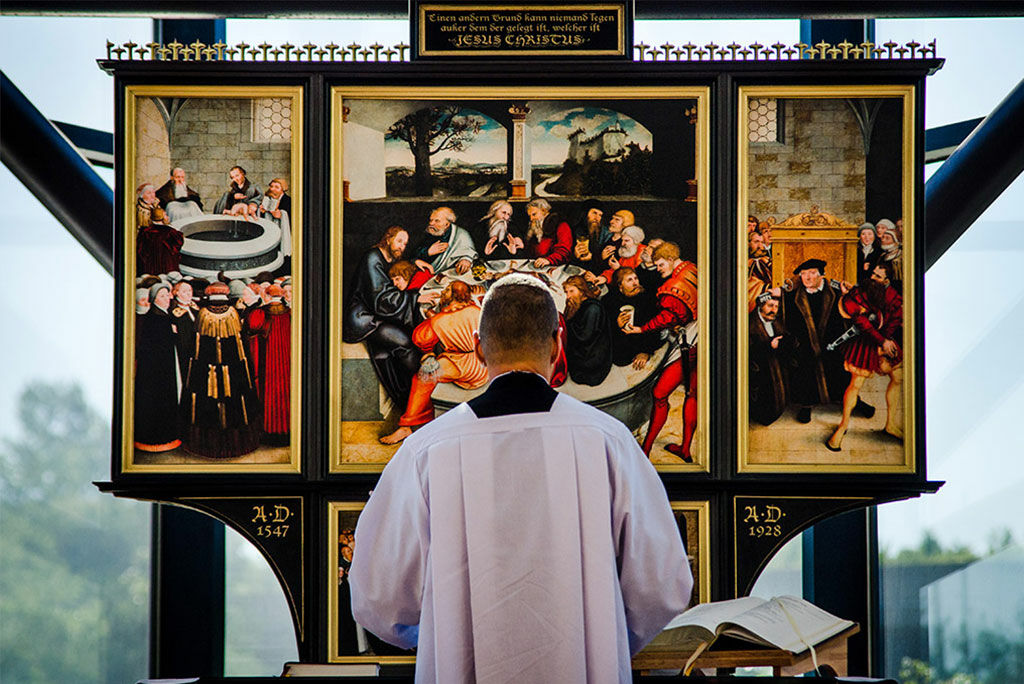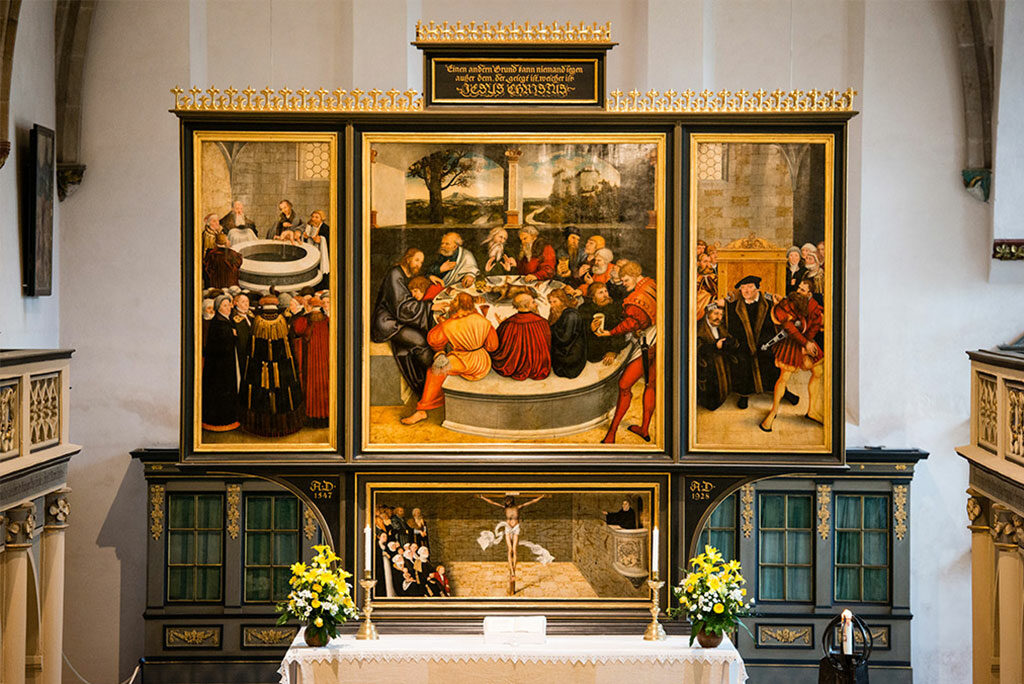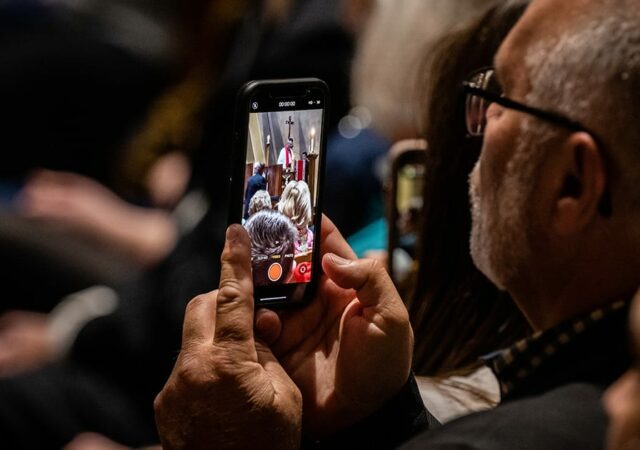
By Kevin Armbrust
A scale reproduction of the Cranach Reformation Altar art at St. Mary’s Church in Wittenberg, Germany, was blessed during a Sept. 19 service at the chapel of The Lutheran Church—Missouri Synod’s International Center (IC) in St. Louis.
Lucas Cranach the Elder, known as “the painter of the Reformation,” was a close friend of Martin and Katie Luther. Many familiar images of Martin Luther come from the brush of Cranach. Lucas Cranach the Younger was the second son of the Elder and worked with his father to complete the Reformation Altar in Wittenberg.
Rev. William C. Weedon, LCMS director of Worship and IC chaplain, blessed the new artwork in the Sept. 19 service. The Rev. Randall L. Golter, special assistant to the Synod president, preached on 1 John 5:1-5 and explained the imagery of the Reformation Altar piece. Golter noted, “Cranach and John point you to the life given in Jesus Christ.”

Cranach’s Reformation Altar art, installed in Wittenberg in 1547, contains a triptych resting on a fourth panel. The triptych depicts in order, from left, Baptism, the Lord’s Supper and the Office of the Keys. Prominent in these three scenes are Wittenberg Reformation figures Philip Melanchthon, Martin Luther and Johannes Bugenhagen.
Underneath these three panels Cranach painted Christ crucified, the foundation upon which the Reformation was established and the Church is built. This bottom panel depicts the congregation on the left, listening to Luther preach from the right side of the panel. Luther’s one hand rests on the Scripture and the other points to Christ. Jesus is in the middle of the panel — the focus of the Word and the foundation of the Reformation.
After the service, LCMS President Rev. Dr. Matthew C. Harrison explained the historical context of the Reformation Altar.
“Luther was dead. And Wittenberg was captured. … It was the worst moment in history of the Evangelical movement,” said Harrison. “It was right in the midst of the greatest difficulties that Cranach makes this painting.”
Harrison introduced the Rev. Dr. William Matzat, the craftsman responsible for overseeing the reproduction project, saying, “There was one man to do the work — Pastor Matzat, who is an artist’s artist.”
The reproduction, which is about one-third the size of the original, contains prints of Cranach’s paintings set in wood panels. In order to construct this altar piece, Matzat crafted hundreds of feet of custom molds.
Matzat explained that the top piece, inscribed with the words of 1 Cor. 3:11 in German (which translated says, “For no one can lay a foundation other than that which is laid, which is Jesus Christ”), is one feature present in this reproduction that is often missing from other reproductions. This text is essential to the Reformation Altar, for there the foundation is established: Jesus Christ.
Matzat later said, “In all my work I seek to express the Gospel of Jesus Christ.” The Reformation Altar proclaims Christ as the foundation of the Church and the Reformation. Matzat explained, “For the Reformation, the Word is the key. The Word is Christ.”

Dr. Kevin Armbrust (kevin.armbrust@lcms.org) is manager of Editorial Services for LCMS Communications.
Posted September 22, 2016





I just preached where the real altar was yesterday!
Beautiful!
Astonishingly beautiful! Thanks be to God for this wonderful tribute to our Lutheran history and Reformation.
Beautiful.
Are prints/reproductions available?
Luther Preaching Christ to the congregation is both humbling and much to the point; we must preach Christ as the center of all.
Deacon Timothy Carter.
Beautiful.
Luther preaching Christ to the congregation is both humbling and very modern: we must preach Christ as the center of all.
Are prints/reproductions available?
Deacon Timothy carter
I am confused. Is not our church a theologically conservative body? Should not these conservative matters apply to the visual as well as the verbal? I am referencing the copy of the Last Supper painting placed above the altar in the International Center chapel. How inappropriate! What is our emphasis during worship?Focusing on our Lord and His redemptive narrative, or observing a museum work of art. Cranach’s work is beautiful and would be appropriately place in the Center’s museum. However, the artist’s work is not fitting for a contemporary worship space. I am a conservative Lutheran (Missouri Synod) and as such, I believe solid theological advice should have been sought before placing the Cranach museum piece in the chapel.
Christians attend services of corporate worship chiefly to receive God’ grace and blessing, and secondarily to offer Him gifts and sacrifices. The action in worship, therefore, should begin at the chancel with its furnishing representing and accenting the means of grace. God’s pursuit spreads outward to the congregation. We respond with our gifts of praise. Therefore, it would be more appropriate that only a Cross be placed on or near the altar-table. The altar should have no embellished reredos that makes it a spectacle. It is a table that functions for the service of communion relating God’s gift to His people. It is also a functional table. Anything positioned on the altar-table that does not assist the meal other than a Cross, Bible, and communion guide, is misplaced. The Cross designed and displayed properly aids in perceiving Jesus and His death at Calvary in all its fullness and grandeur. An art piece with portraits of Melanchthon, Luther, Bugenhagen, and others should not overtake an image alluding to Jesus and His glorious redemption.
A quality appreciated in a church building is simplicity. Decoration tends to draw attention to itself and distracts from worship. Nonessential objects give a confused credo when imprudently placed in the chancel. The building should be pure and genuine – no artificialities, no cosmetic, distracting ornamentation – only a clear, authentic Christian testimony. Only the three means of grace should be accented from the front of the worship space. Although the Cranach copy projects communion, it adds confusion.
The emphasis must be kept where it belongs. Our only glory is the Cross of Christ. Our swagger is not how much we love God; rather how much He loves us. Paul states: “But may it never be that I should boast, except in the cross of our Lord Jesus Christ . . . ” (Galatians 6:14a). The Christian persuasion is the belief in the Lord Christ who bore the Cross for all mankind. Thus faith finds its worth not in the believer, but in the believed One, the crucified Lord and Savior. Therefore, we do not glory in our grasp of Jesus; rather, we glory in His grasp of us. Hence, the Cross alone as an artistic expression in the chancel is a much more appropriate visual than depictions of the apostles who at Jesus’ final supper did not yet understand His undertaking, plus several sixteenth century saints. Sound theology may have been overlooked in the new addition to the chapel.